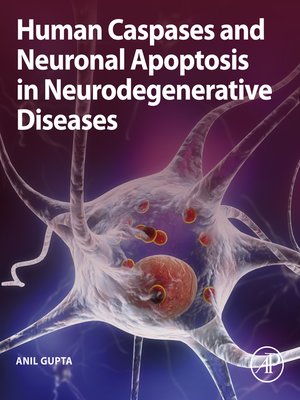
Sign up to save your library
With an OverDrive account, you can save your favorite libraries for at-a-glance information about availability. Find out more about OverDrive accounts.
Find this title in Libby, the library reading app by OverDrive.



Search for a digital library with this title
Title found at these libraries:
| Loading... |
Human Caspases and Neuronal Apoptosis in Neurodegenerative Diseases elucidates elaborately the role of caspase enzymes implicated in the initiation of molecular events leading to neuronal apoptosis in the neurodegenerative disease. The book starts with introduction to neuropathology, neurogenetics, and epidemiology of neurodegenerative disease and illustrates the involvement of human caspases, neuronal apoptosis, apoptotic pathways, genetic polymorphisms, and several other factors and underlying mechanisms in the pathology of Alzheimer's disease, Parkinson's disease, and Huntington's disease. An important focus in all chapters is the intricate mechanisms and interplay that occur during or leading to neuron death in neurodegenerative diseases, along with disease pathobiology. Provides in-depth knowledge about neurotoxic potential of transition metals, impaired mitochondrial dynamics in the brain neurons, mutant proteins Aß peptide, tau protein, a-synuclein, huntingtin protein and formation of Lewy bodies, reactive oxygen and nitrogen species, ubiquitin proteasome dysregulation, and many others in neurodegenerative diseases Elucidates neurogenetics of gene APP, gene PSEN1, gene APOE, gene LRRK2, gene DJ1, and others in the pathology of neurodegenerative diseases Explains caspases-mediated neuronal apoptosis in pathogenesis of Alzheimer's disease covering amyloidogenesis, caspase-activated DNase, rho-associated coiled coil–containing protein kinase 1, mammalian sterile 20-like kinase 1, role of synaptic loss, microglial TREM2 receptor, microglial LRP1 receptor, microglial advanced glycation end-product receptor, astrocytic glial a 7 subtypes of nAChR, NLRP3 inflammasome, P2X purinoreceptors, miRNAs, and many other factors Demonstrates the role of caspases and apoptosis in Parkinson's disease covering truncation of a-synuclein, neuroinflammation, parkin protein, activation of microglial cells, extrinsic and intrinsic pathways of apoptosis, ?tau314, and several other factors Explains etiopathogenesis of Huntington's disease through covering clinically important topics as role of exon 1 HTT protein, ubiquitous nature of huntingtin, length of expanded polyglutamine tract, classically and alternately activated microglia, nuclear factor kappa B, kynurenine signaling pathway, tumor suppressor protein, PGC-1a gene, advanced glycation end-products, autophagy, and many other significant topics






